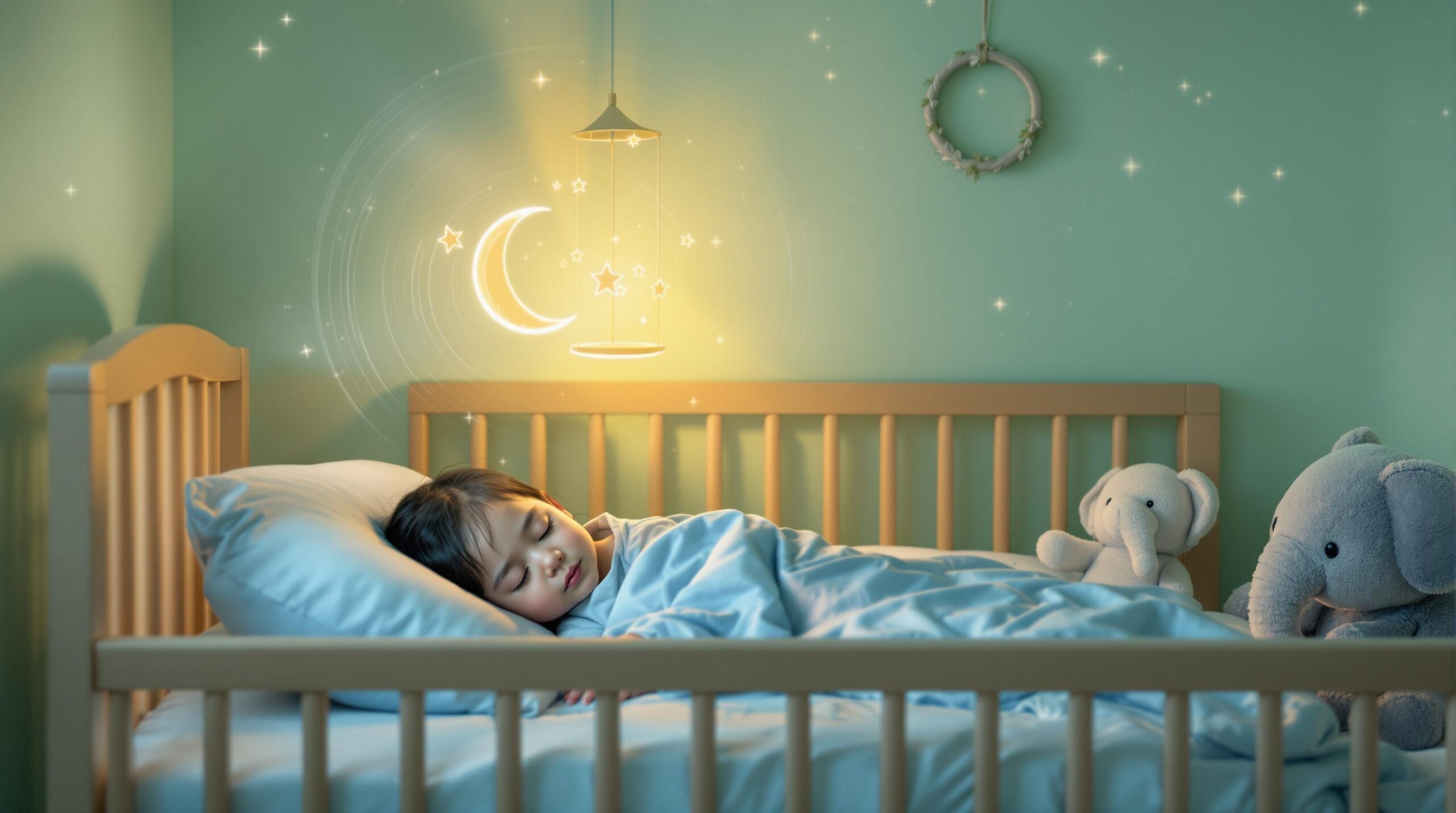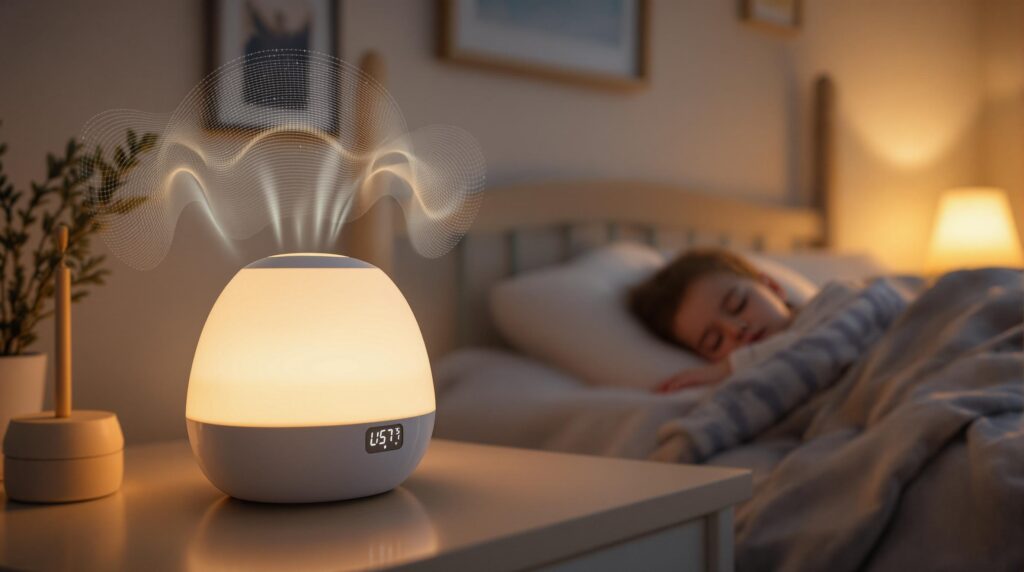Table of Contents
ToggleAs a parent, you’re likely familiar with the challenges of getting your toddler to sleep soundly through the night. One solution that’s gained popularity in recent years is the use of white noise. But does it really help? Let’s explore the role of white noise in toddler sleep and how it might benefit your little one.
What is White Noise and How Does It Work?
White noise is a consistent sound that contains all audible frequencies at the same intensity. It’s often described as a steady “shhhh” sound, similar to the noise of a fan or gentle rain. The magic of white noise lies in its ability to mask other disruptive sounds that might otherwise wake your toddler.
Unlike its cousins, pink noise (which has more power in lower frequencies) and brown noise (which has even more emphasis on lower frequencies), white noise maintains an equal power across all frequencies. This unique characteristic makes it particularly effective at creating a blanket of sound that can help soothe your toddler to sleep.
The mechanism behind white noise is simple yet powerful. By providing a consistent auditory backdrop, it helps to drown out sudden noises that might startle your child awake. Think of it as creating a cocoon of sound around your toddler’s sleep space, shielding them from the outside world’s unpredictable noises.

Toddler Sleep and Developmental Stages
To understand why white noise can be so helpful, it’s important to consider your toddler’s developmental stage. From birth to about 2 years old, children are in what psychologists call the sensorimotor stage. During this time, they’re learning about the world primarily through their senses and motor actions.
This stage has a significant impact on sleep patterns. As toddlers develop object permanence – the understanding that objects continue to exist even when they can’t be seen – they may experience separation anxiety at bedtime. This can lead to difficulties falling asleep or staying asleep through the night.
White noise can play a crucial role during this stage by providing a constant, comforting presence. It can help ease the transition from being with parents to being alone in their crib or bed. Toddler sleep regression is common during this period, and white noise can be a valuable tool in your arsenal to combat these sleep disruptions.
Benefits of White Noise for Toddler Sleep
The benefits of white noise for toddler sleep are numerous and backed by research. Here are some key advantages:
Creates a Consistent Sleep Environment
White noise provides a consistent auditory environment, regardless of what’s happening outside your toddler’s room. This consistency can be incredibly comforting for young children, who thrive on routine and predictability. Whether you’re at home, traveling, or staying with relatives, white noise can help recreate a familiar sleep environment for your toddler.
Reduces Sleep Disruptions
By masking sudden noises, white noise significantly reduces the likelihood of sleep disruptions. This is particularly beneficial if you live in a noisy environment or have other children in the house. The steady hum of white noise can help your toddler stay asleep even when the dog barks or a car honks outside.
Promotes Longer, More Restful Sleep
Studies have shown that white noise can help babies and toddlers fall asleep faster and stay asleep longer. This can lead to more restful, restorative sleep, which is crucial for your toddler’s growth and development.
The National Sleep Foundation reports that white noise can increase sleep time and reduce the number of night wakings. This can be a game-changer for both toddlers and their sleep-deprived parents!
Safety First: Using White Noise Responsibly
While white noise can be incredibly beneficial, it’s crucial to use it responsibly to protect your toddler’s hearing. The National Institute on Deafness and Other Communication Disorders (NIDCD) provides guidelines for safe noise levels:
Maintaining Safe Volume Levels
The volume of your white noise machine or app should be no louder than 50 decibels. This is about the volume of a quiet conversation or a running refrigerator. It should be loud enough to mask disruptive noises but not so loud that it overwhelms your toddler’s hearing.
Choosing Appropriate Devices
When selecting a white noise machine or app, look for ones with built-in safety features. Some devices automatically shut off after a certain period, while others have volume limiters to prevent the sound from becoming too loud.
Placement Matters
Place the white noise source at least 7 feet away from your toddler’s sleeping area. This helps ensure that the sound isn’t too intense at your child’s ear level.
Remember, your toddler’s hearing is still developing, so it’s essential to err on the side of caution when it comes to noise exposure.
The Parent’s Role in White Noise Usage
As a parent, your role in using white noise effectively is crucial. Here’s how you can ensure you’re using this tool to its fullest potential:
Monitoring Your Child’s Response
Every child is different, and what works for one might not work for another. Pay close attention to how your toddler responds to white noise. Do they fall asleep more easily? Do they stay asleep longer? Or does the noise seem to agitate them? Your observations will guide your white noise strategy.
Adjusting Your Approach
Based on your observations, be prepared to adjust your approach. You might need to experiment with different types of white noise, volume levels, or durations to find what works best for your toddler.
Communicating with Healthcare Providers
If you have concerns about your toddler’s sleep or the use of white noise, don’t hesitate to discuss them with your pediatrician. They can provide personalized advice based on your child’s specific needs and development.
Remember, white noise is a tool to enhance sleep, not a replacement for good sleep hygiene. It should be part of a comprehensive sleep training strategy that includes other important elements.
Complementary Sleep Strategies for Toddlers
While white noise can be a powerful tool, it’s most effective when used in conjunction with other sleep-promoting strategies. Here are some complementary approaches to consider:
Establishing Bedtime Routines
A consistent bedtime routine signals to your toddler that it’s time to wind down and prepare for sleep. This might include activities like a warm bath, reading a story, or singing a lullaby. The key is consistency – try to do the same activities in the same order each night.
Creating a Sleep-Friendly Environment
In addition to using white noise, ensure your toddler’s sleep environment is conducive to rest. This means keeping the room dark (consider blackout curtains), maintaining a comfortable temperature (around 68-72°F), and using comfortable, breathable bedding.
Limiting Screen Time
The blue light emitted by screens can interfere with your toddler’s natural sleep-wake cycle. Try to avoid screens for at least an hour before bedtime. Instead, engage in calm, screen-free activities that help your toddler relax.
Encouraging Physical Activity During the Day
Regular physical activity during the day can help your toddler sleep better at night. Ensure your child gets plenty of active playtime, preferably outdoors, but not too close to bedtime.
These strategies, combined with white noise, can create a powerful sleep-promoting routine for your toddler. The goal is to help your toddler sleep in their own bed comfortably and consistently.
Long-Term Considerations and Gradual Reduction
While white noise can be a fantastic sleep aid, it’s important to consider its long-term use and how to eventually reduce dependence on it.
Potential for Habituation
With prolonged use, some children may become habituated to white noise, meaning they rely on it to fall asleep. While this isn’t necessarily problematic, you might want to consider gradually reducing its use as your child grows older.
Strategies for Gradual Reduction
If you decide to phase out white noise, do so gradually. You might start by lowering the volume slightly every few nights. Alternatively, you could begin using it only for naps or only at the start of the night, gradually reducing its presence in your child’s sleep routine.
Transitioning to Natural Sounds
As your child grows, you might consider transitioning from white noise to natural sounds like gentle rain or ocean waves. These can provide a similar masking effect while introducing variety and potentially easing the transition away from constant noise.
Remember, there’s no rush to eliminate white noise if it’s working well for your family. Many adults find it beneficial for sleep, so don’t feel pressured to stop using it if it continues to help your child sleep soundly.
In conclusion, white noise can be a valuable tool in helping your toddler achieve restful sleep. When used responsibly and in conjunction with other sleep-promoting strategies, it can lead to longer, more consistent sleep for your little one. As with any parenting strategy, the key is to observe your child’s responses and adjust accordingly. Sweet dreams!
If you’re still facing challenges with your toddler’s sleep, don’t lose hope. Overcoming sleep regression setbacks is possible with patience and the right strategies. Remember, every child is unique, and what works best for your family might take some trial and error to discover.
Sources:
American Academy of Pediatrics – HealthyChildren.org
National Institute on Deafness and Other Communication Disorders – NIH
Centers for Disease Control and Prevention – CDC
U.S. Department of Health & Human Services – Health.gov
Stanford Children’s Health – Lucile Packard Children’s Hospital
Harvard Health Publishing – Harvard Medical School
National Sleep Foundation – NSF
Mayo Clinic – Mayo Clinic Health System
University of Michigan Health – Michigan Medicine
Cleveland Clinic – Cleveland Clinic Health Essentials












